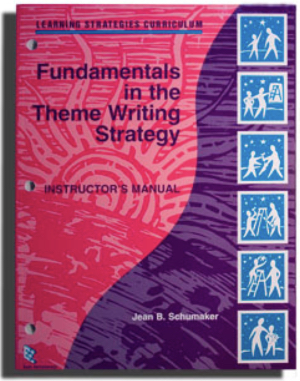Fundamentals in the Theme Writing Strategy

Writing themes or essays can be a daunting challenge. However, once students learn the building blocks, they can create TOWERs of power! With this program, they learn how to plan and write a basic theme containing an Introductory Paragraph, Detail Paragraphs, and a Concluding Paragraph. They learn how to vary the structure of these paragraphs and to grab their readers’ attention using a variety of options.
The Theme Writing Strategy focuses on the fundamental skills associated with writing themes and provides learning sheets to accompany instruction.
Author(s):Jean B. Schumaker
Publication Info: Edge Enterprises, Inc.
RESOURCES:
Fundamentals of Theme Writing Strategy Research (.pdf)
RESEARCH ARTICLES:
- Schumaker, J.B., & Deshler, D.D. (2009). Adolescents with learning disabilities: Are we selling them short? Learning Disabilities Research & Practice, 24(2), 81-92. The authors review the evolution of SIM writing strategies and research that shows students with learning disabilities can learn and successfully use writing strategies under the right instructional conditions.
- Schumaker, J.B., & Deshler, D.D. (2003). Can students with LD become competent writers? Learning Disability Quarterly, 26(2), 129-141. This article summarizes a programmatic line of R&D work that has focused on learning strategies instruction as a method for improving the writing performance of students with disabilities within the context of the general education curriculum as well as on district- and state-wide writing assessments.
The Story Behind the Theme Writing Strategy Program from author, Jean B. Schumaker, Ph.D.:
I started developing instructional programs for writing skills in the 1970s when I was a graduate student at the University of Kansas. My graduate program required me to take part in an internship at the probation department of the Douglas County Juvenile Court in Kansas. I was assigned several cases of truant secondary students. In working with these students, I learned that they could not write. They told me that one of the reasons they avoided school was that they were embarrassed because they could not complete the work assigned to them. I also learned that there were no instructional programs available to teach them writing in an intensive way. I embarked on a journey of developing writing programs that continues to this day, and several colleagues have joined me along the way.
The Theme Writing Strategy instruction is founded on principles that were taught to me by my high school English teacher, Mr. Brasher, from whom I was lucky to learn during all four years of high school. He created a diagram that we were to fill out before we began writing our themes. He also coached us in how to think as we were creating our diagrams and how we were to use transition sentences to provide the glue for our writing. He assigned 15-page papers when we were freshmen and never backed off on his expectations, despite many complaints from students and parents. Many of the complaints centered on the notion that students needed more prerequisite instruction before they should be required to write 15-page papers. Thus, Mr. Brasher’s ideas have been used as a foundation in the Fundamentals in the Theme Writing Strategy program to provide students with the fundamental skills they need to write themes and essays comprised of five or six paragraphs. The TOWER Diagram is a very simplified version of Mr. Brasher’s diagram, and the program involves intensive instruction in key types of sentences that form the glue within a theme. This program was designed to follow instruction in the Paragraph Writing Strategy, and the vocabulary used throughout this program is coordinated with the foundational vocabulary and instruction in the Paragraph Writing Strategy and the Sentence Writing Strategy programs.
Author's Thoughts about Strategic Instruction
Strategic instruction is one of the few instructional methods that have been shown to be effective through empirical research to produce improvement in the learning and in the academic performance of at-risk students. The studies conducted on the instructional program for the Theme Writing Strategy have shown students can learn to write well-organized themes and can generalize their use of theme-writing skills to their coursework and testing situations when this program is used with fidelity. Instruction in the Theme Writing Strategy has been included in scope and sequence plans at the middle-school and high-school levels in numerous districts across the nation. The strategy has been taught in general education and special education settings to a wide variety of students.
Teacher and Student Feedback on the Theme Writing Strategy Program
Teachers often report that the TOWER Diagram is a revelation for students, and they become less afraid to write a theme. The patterns set up for the introductory and concluding paragraphs are like security blankets for students, and their confidence in their writing builds during the Theme Writing Strategy instruction. Once their fears are allayed, they become more and more willing to engage in writing, and they feel more pleased with their writing.
This product is published by Edge Enterprises, Inc.
Please note that professional development, coaching, and infrastructure support are essential components to effective implementation of SIM instructional tools and interventions. It is highly recommended that you work with a SIM professional developer. See the SIM Event list for sessions or email simpd@ku.edu to learn more.
An accessible version of the documents on this site will be made available upon request. Please contact the KU CRL Professional Development Research Institute, at simpd@ku.edu to request the document be made available in an accessible format.